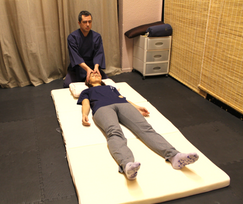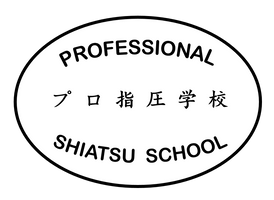Fernando Cabo, the director of the Professional Shiatsu School has developed the Heisei Shiatsu style. Heisei means serene, tranquil, calm, restful, peaceful. The name was chosen to empasize the peace of mind and profound relaxation that are the aims of any shiatsu therapy session.
His interest in promoting shiatsu as a profession is reflected in the name of the school.
Interview with the director of
the Professional Shiatsu School
Q: Is the shiatsu you practise different to other shiatsu styles? In what way?
A: Heisei shiatsu 平静指圧 is different to many shiatsu styles in that the main tool
to apply shiatsu is the thumb.
We use both thumbs next to each other in about 80% of the treatment.
Other styles use much more the palms and the arms, and thumbs are used
much less, and they are used either bilaterally, or one thumb pressing while
the other hand is stationary, instead of using both of them as one unit
as we do.
Q: What are the benefits of using the thumbs?
A: Using the thumbs as much as we do has advantages and disadvantages.
The main disadvantage is that beginners may experience some stiffness at the
base of the thumb, because we don't normally use those muscles. It doesn't
last long, and it goes away with practice.
There are, however, very important advantages. The thumb is home to a very
large number of mechanoreceptors, so, with practice, it can become very
sensitive to the state of muscles and tissues. It is much more sensitive than
many other parts of the body. This allows us to feel hypertonicity or
hypotonicity in muscles (yin and yang in traditional terms), and change our
pressure accordingly.
We are diagnosing, if you will, the state of the body at the same time we are
working. This is more difficult to do with the palms of the hands or the elbows,
which are not as sensitive.
The thumb is also a much more precise tool to find exact points than larger
areas such as the palms of the hands. And, it is very easy to change the angle
of the thumb to the heels of the hand to adjust pressure. Without changing
our position, we can apply from the lightest to the strongest pressure.
Q: Why does it take so long to train in shiatsu compared to other types of
massage?
A: First, because one of the aims at the Professional Shiatsu School is to teach
the students how to acquire a deep, pleasant and painless pressure. It is not
difficult, but it takes time. When you are a beginner, you don't realise when
your pressure is hard or painful. So the teacher needs to check and correct
the way pressure is applied. It takes time and practice.
Second, because students need to learn how to work on a futon, on a couch
and on a chair. They need to learn the correct posture so they can work
a full day without getting tired. We teach efortless shiatsu in which each
treatment is a type of meditation.
And finally, because we include clinical practice in our training.
A: You have mentioned painless pressure. Does this mean that Heisei Shiatsu is a
very gentle form of shiatsu?
Q: Well, it depends what you mean by gentle. If by gentle, you mean a light
touch or superficial pressure, then, no, it is not gentle. When I was in
Brighton for shiatsu awareness week, some years ago, a few people told me
they had never received such a deep shiatsu. But our deep pressure is not
pointy or penetrating, it is painless. So in that sense, yes, it is gentle.
Q: I understand that shiatsu is based on the concept of balance.
A: That is right. Balance is an essential basis to promote the health benefits of
a shiatsu session. This concept begins with the general notions of yin and yang,
internal and external, etc. and it encompasses balance within the
autonomic nervous system, which controls many of the bodily functions,
such as the peristalsis in the digestive system, blood pressure, blood flow
to skeletal muscles, the production of insulin, the induction of sleep and
many more.
In order to achieve muscular, nerve and general balance, we change our
pressure according to what we feel. But it is a whole body balance we are
talking about. This concept is the basis of sotai too.
Q: Why is Heisei Shiatsu different from some of the other styles?
A: Because Heisei Shiatsu has influences from different shiatsu stykes and from
clinical practice. Heisei shiatsu has been influenced by Keiraku Shiatsu and
Namikoshi Shiatsu. Namikoshi Shiatsu is the type of shiatsu
you need to know in Japan in order to take the government exam in shiatsu and
obtain a licence to practise, but some of the concepts of Keiraku Shiatsu
are very important, so we have incorporated them.
Heisei Shiatsu has incorporated many ideas from both these main styles,
such a how to work on the hara (abdomen), which is very beneficial for our
health, and on the head, which is profoundly relaxing.
Heisei Shiatsu has also been adapted to clinical settings, to the types of cases
one is likely to encounter in real-life situations, when people come to us
for shiatsu treatment.
This is the reason why the clinical practice year includes working with real
patients under the supervision of the teacher and gives the opportunity
to obtain the Postgraduate Diploma in Clinical Practice by working in a
hospital with cancer patients.
Q: Do you put a lot of emphasis on using the katas?
A: Our katas or sequences are not something to adhere to.
We use them above all in the first year of our training. As I explained before,
Heisei shiatsu has been adapted to real life. A sequence is a learning tool that
teaches us the points we can press on the body, and the best body and hand
position to do it. It serves us as a guideline, but we need to adapt and
modify it for the person or condition we are treating.
All students begin their learning journey once they graduate. They need to
incorporate their life experiences and their particular sensitivity to touch into
their practice. It is a beautiful journey that never ends.


